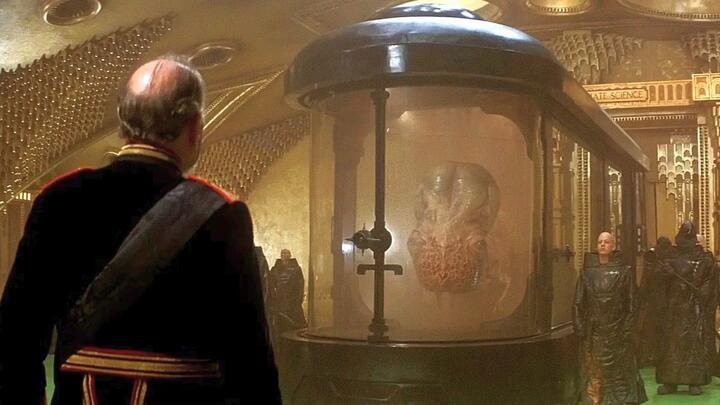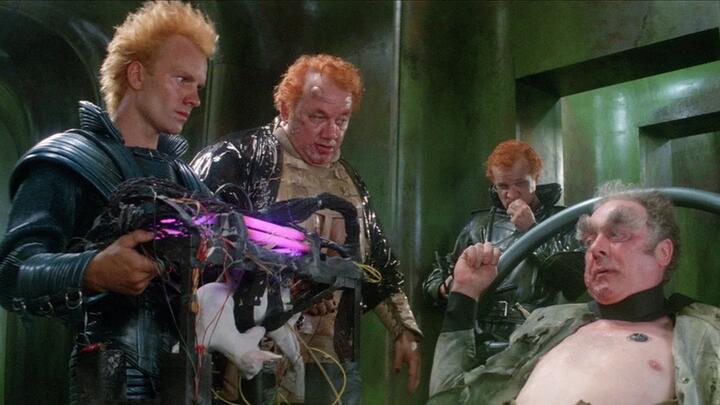The 1984 film adaptation of Dune was and still is much maligned. But there are a few things that make it better than the current attempt by Villeneuve, whose Dune: Part Two is currently showing in cinemas.
Arrakis, Dune, desert planet, movie flop. There’s no shaking that for now. When Frank Herbert’s socio-political sci-fi saga was first filmed in the early 1980s, Universal and producer Dino De Laurentiis were after an adventurous blockbuster that could rival Star Wars. The result from director David Lynch not only fell short of expectations at the box office, but also caused fans and critics alike to frown.
But to be honest: if I have the choice between a rewatch of Dune (1984) and Denis Villeneuve’s universally acclaimed Dune (2019), whose sequel Dune: Part Two is currently showing in cinemas, I usually go for the retro model. Am I just a Lynch fanboy who doesn’t want to know any better? Or does the old film version have a lot to offer that puts the New Kwisatz Haderach on the Block in the shade?
David Lynch’s Dune is overflowing with design ideas
The fact that the director of Eraserhead and The Elephant Man was hired for the lavish project must have seemed like the more moderate, audience-friendly option at the time. Before Lynch, the avant-gardist Alejandro Jodorowsky, who hovered in even more surreal spheres, tried his hand at a version that was as ambitious as it was megalomaniacal and came to nothing.
Perfect for sci-fi fans: stream the brilliant Dune film now for free
In contrast, Lynch’s film seems frighteningly “normal”, even in the context of his other films. Fragments of a dreamy, other-worldly film with a unique signature and vision persist, even despite studio influence. Above all, however, the film shines in terms of production design. Each space noble house on each planet has its own look and vibe with creative costumes and expansive sets made from different materials.
Caladan, for example, the home of Paul Atreides (then Kyle MacLachlan, now the almost equally beautiful Timothée Chalamet), is made of warm wood, while Giedi Prime, the enclave of Baron Harkonnen (Kenneth McMillan), was fabricated from poisonous green metal and the Emperor’s (José Ferrer) residence can be described as a lavish nightmare of gold.

(Dune (1984)
Villeneuve, on the other hand, seems a little afraid of flourishes, colors and the potential to slip into the camp camp due to less good taste. So, like a Sad Beige Mom on TikTok, he sticks to the same shades of yellow and gray. It’s all a question of style and preference, of course. But the settings and factions are visually almost indistinguishable from one another. And with all the empty space in the picture, you could be forgiven for thinking that a perfume is about to be advertised. Spice … by Paul Atreides.
If Dune84 were a Batman, it would be Tim Burton’s stylized one, while Dune19 emulates Christopher Nolan’s Dark Knight: condemned to be set in a world that seems far too realistic despite its imaginative template. Sad!
People and inner monologues are good, actually
I don’t know about you, but I like it when filmmakers get personally involved instead of just serving as good adaptation avatars of a template. Lynch’s version indulges in charming eccentricities, such as the monstrously designed, almost iconic guild navigator, the bizarre cat box, space gates decorated with gold frames and, last but not least, the space pugs lovingly carried through the film by Patrick Stewart.
Villeneuve deletes and streamlines elements rather than adding them, apart from the repartee humor, which occasionally teeters dangerously on the brink of pleasing Marvel dialogue. And how many space pugs does he offer us? Huh? Zero. Zero space pugs. J’accuse!

(Dune (1984)
A frequent criticism of the old Dune is the allegedly questionable use of inner monologues. However, the fact that these are always a minus point is, in my opinion, a trueism that doesn’t apply here at all. In this case, the revealed world of thoughts reinforces the wobbly dream feeling and also gives the chance to keep unspoken lines from the original novel in the movie.
Of course, not every movie should use them. But, as with the tiresome “show, don’t tell!” – the internalized wisdom that films should only show rather than tell – inner monologues are criticized far too reflexively. Sometimes, however, just like elements that are told rather than shown, they are absolutely passable, if not excellent.
What annoys me and is less easy to defend
Dune from 1984 is anything but a perfect movie. David Lynch, who has long since distanced himself from the project, would be the first to admit that. And some things are indeed hard to defend. The whitewashing of characters who probably really shouldn’t be white, which was commonplace in Hollywood at the time, is the first thing that comes to mind. But I can also hardly gloss over the pacing in the 2nd half and the tedious battle scenes.
In addition, the movie doesn’t do justice to Paul as the supposed savior and lets the Baron degenerate from a brilliant schemer to a cartoon villain. That’s a shame, but can be explained by the similarly knitted Star Wars, which was the declared target. Perhaps the never-shot sequel, whose script was only discovered this year, would have brought a little more depth to the story

